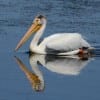 By Jim Stevenson
By Jim Stevenson
I hope all you guys had a great week and aren’t agonizing too much over returning to work soon. My two clients and I shot Bosque del Apache this morning (about 15 degrees!) and watched the skies explode with Snow Geese at dawn. This is Part One of a pair of galleries on swimming birds, perhaps geared more for beginners. I dunno. Heading into AZ en la manana.
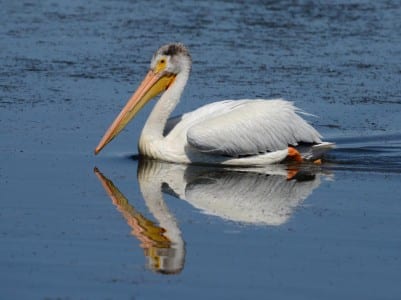
There are large species of “white” pelicans all over the large World, and other large species of large dark ones. Most large white ones, like our large White Pelican, are largely freshwater, scooping up large f ish in large lakes and large impoundments. Most large dark ones, like our large Brown Pelican, are largely marine. The large white ones are usually larger, although the reeeeeeally large Chilean Pelican is a whopper.
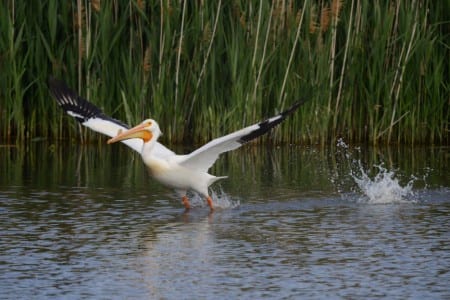
Many swimming birds are so heavy they have to paddle across the surface to get airborne when danger comes. Curiously, while most of these, like coots & diving ducks, alternate their “steps” as they are taking off, White Pelicans often paddle both feet at once. They also have black secondaries and not just primaries, a bit like storks.
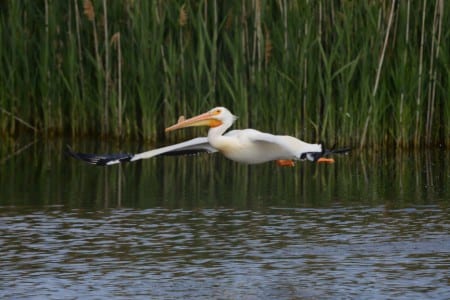
Having wings this wide and long (110-inch wingspan) they can glide for long distances, and migrating flocks of White Pelicans appear and disappear as they turn in sync (there’s not room in my sink for one). Also check out the ornamentation on the bill, a sure sign of breeding condition. (These two were leftovers from last summer.)
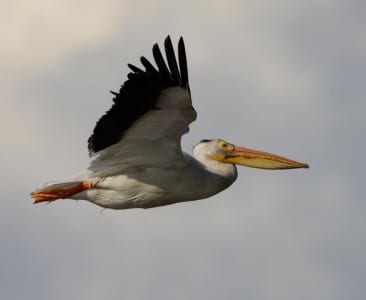
Pelicans have huge feet to motor their monstrous bodies, and the webbing is totipalmate – it reaches around to the hind toe. Their inflatable pouch expands when filled with water, so they can scoop fish easily. They are winter residents in our area, summering north and west in places like the Great Salt Lake.
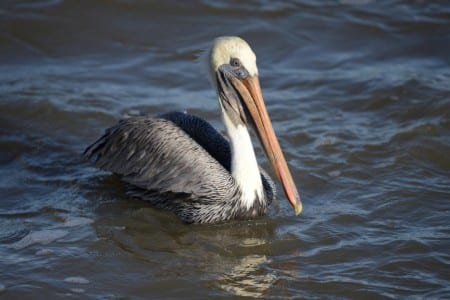
Brown Pelicans always look large until you see one beside a White Pelican! Many adults are largely white on the head and neck, and they never have the ornamentation on the bill found in Whites. Browns were the pelican which was hurt so badly by DDT, and it is a neat thing seeing how they’ve come back since DDT was outlawed.
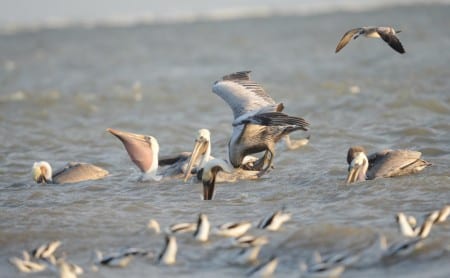
Brown Pelicans usually feed by diving out of the air and gulping surface-feeding fish in their cavernous bills. This usually separates them ecologically from White Pelicans, as a certain amount of depth is required for this behavior. It is interesting to see the avocets swimming near the pelicans, taking small animal life, as well as the Laughing Gull over the pelicans, watching for scraps.
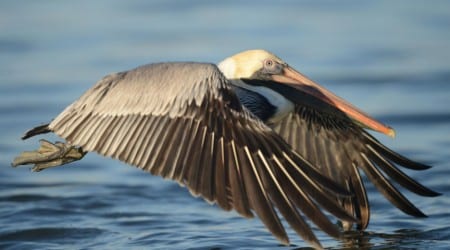
This is an adult taking off on the Galveston CBC. Note the color in the bill and the massive feet. They also have enormous wings to serve the heavy body’s desire to fly.
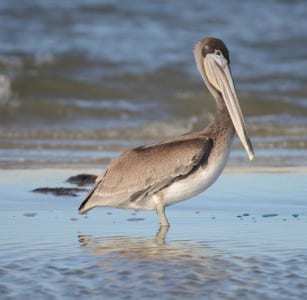
First-year Brown Pelicans lack much color & pattern, but in all birds the immatures reach the adult size in 6-8 weeks. Many of these nest on Little Pelican Island, but they are very abundant nesters in South Florida. These youngsters have a scalloped look on the back, a bit like a Baird’s Sandpiper, and are plain gray-brown like many young birds.
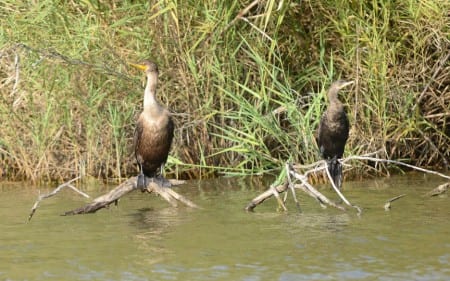
Our two immature cormorants are not too hard to distinguish. The Neotropic on the right has a lighter chest that’s brown, while a young Double-crested on the left is nearly white. DCs are also heavier with a shorter tail and their gular pouch is not angled at the back the way a Neotrop is. I wonder how many of you remember the old name of the Neotropic, the “Olivaceus.” Or the one that’s brown, white and pink, the Neapolitan? 😉
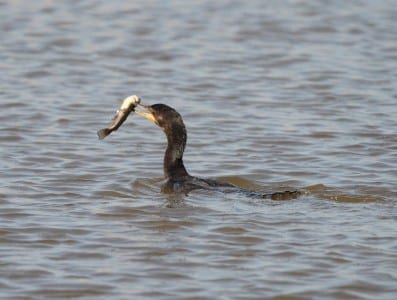
This adult Neotrop has a smallish catfish, probably taken from near the bottom of this canal. All birds must be careful when swallowing catfish because of the dorsal and pectoral fins. Birds like great blues can hammer those fins till they break, but cormorants just have to be sure the fins are lying down when they swallow.
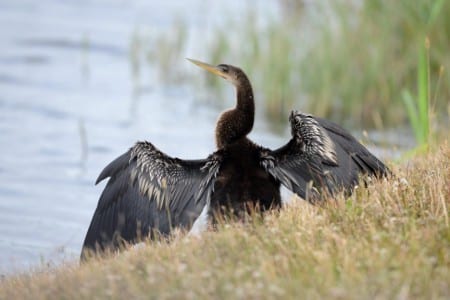
Anhingas, which do not normally occur on Galveston, have a dagger bill with no nail like is seen on cormorants’ beaks. Obviously they spear their prey, often choosing fish shaped more like a bream than a catfish. They also have white flecking on the leading edge of wings, and longer, slimmer dimensions. They are almost entirely freshwater creatures, except for the causeway to Sanibel Island. Go figger.
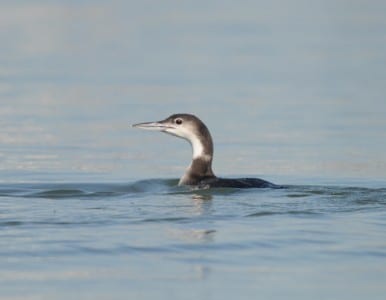
Common Loons have f inally arrived and are filling up Offat’s Bayou in Galveston. Note the light-colored dagger bill, and how divers ride so low in the water. Loons (and the grebes coming next) are very ancient birds, dating back to the time of the dinosaurs. I am at a loss to explain why some field guides are placing them after birds like waterfowl, which clearly appeared on Earth after loons and grebes.
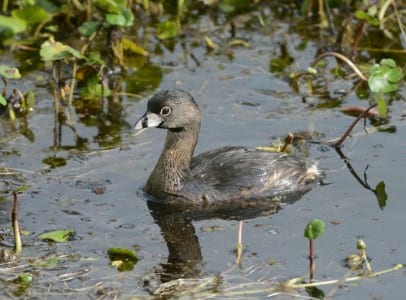
There is very little color change in Pied-billed Grebes between the seasons. This bird is in breeding plumage, but when fall comes the black bar on the bill and the black throat will disappear. This isn’t nearly as much seasonal change as on a few other grebes like Eared. The eyering is also diminished in winter.
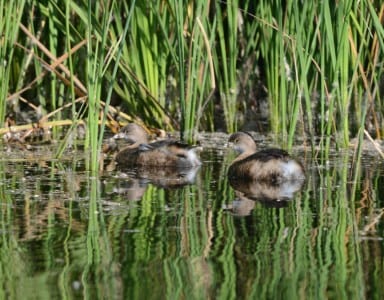
These two October birds are losing their bar and have no black throat now, so you can see the progression. You can also see all the down feathers, etc., in the rush behind them, as this pond at Brazoria NWR is loaded with waterfowl. It’s also a good way to tell from which direction the wind has been blowing lately!
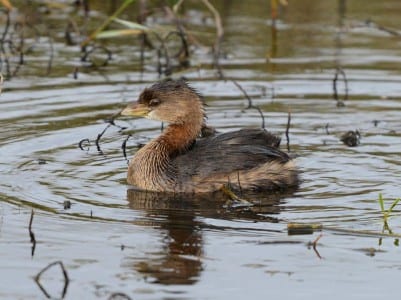
Now, finally, this Pied-billed Grebe is in full winter (basic) plumage. Well, there is the tiniest little dark dot leftover from the bar, but for all intents and purposes, this is nonbreeding plumage. (Yes, there are three names for the same plumage.) The three names for March through August are breeding, alternate and summer plumage.
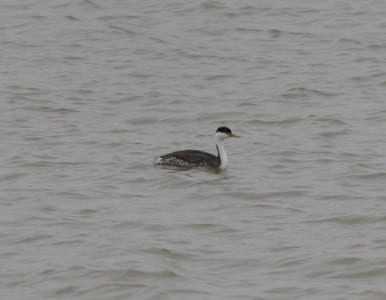
An exciting f ind was a week or so ago when my friend Alice Ann and I drove down to Brazoria County to birdwatch and eat mass quantities of seafood. This beast was in the ditch near Buckeye’s, and is a Western Grebe. This may have been the first record for the UTC, and it’s told from the Clark’s Grebe by the eye being covered by black.
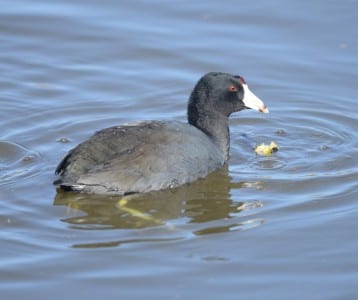
American Coots are one of several coots around the World, all looking pretty similar (except the old coot). They are largely vegetarians, and true to form, this one is attacking some vegetable matter it ripped from the reeds. Of course, in summer, they feed animal life to their chicks for the protein. Note the vertically flattened bill, unlike ducks.
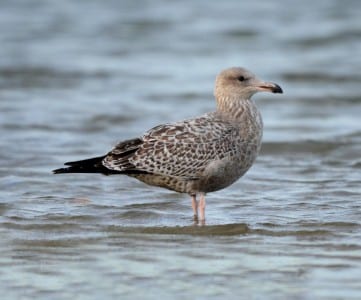
Gulls and terns have webbed feet and swim some, usually to rest and sleep beyond the reach of humans and other predators. This is a juvenile Herr ing Gull, quite the common bird on the Gulf Coast in winter. They are much browner than others of our common, young gulls, and obviously very large. This is a male, owing to its very large size, and really, the crown is a bit more rounded than most Herring Gulls.
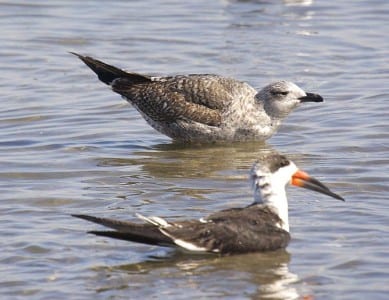
Juvenile Lesser Black-backed Gulls are also kinda brown all over, but you can see that he’s not a LOT bigger than this skimmer. LBBGs are also a tad darker on the mantle than the head, chest and belly, and, well, the head is normally more rounded than Herring. The black bill can also be a tip-off, although I’d use as many field marks as possible.
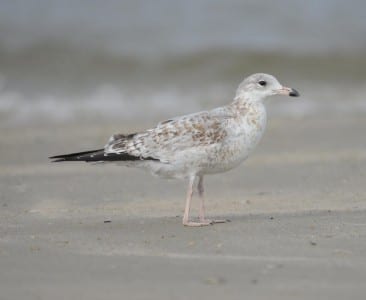
Immature Ring-billed Gulls also morph from the typical brownish speckled coloration to the “light gull” adult we see on the beaches. This one’s a second-year bird and I’m guessing will mate and reproduce the following summer. Note the pink legs of the subadult but the yellow legs of the adult RB are coming. Two more things: A rounded head and slim body, not nearly as heavy as Herring.
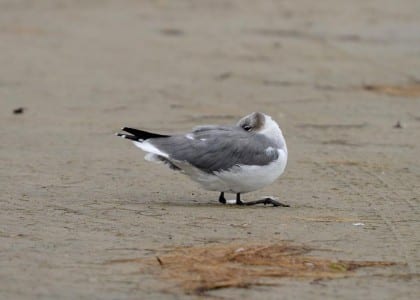
Adult Laughing Gulls are one of several “black-headed” gulls that lose their hood in fall and winter. This poor soul is missing its left leg, perhaps to a blue crab, crab trap, fishing line or whatever. This is not unusual and gulls seem to be able to make a living along the shores despite their handicaps. (I’m thinking of all sorts of lame jokes.)
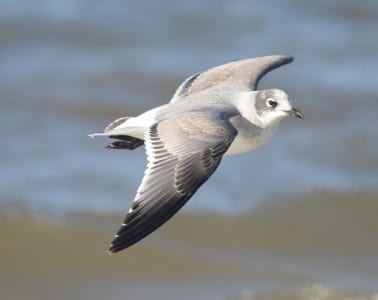
Franklins Gulls are another of those gulls with dark heads in the breeding season, so when they’re here in late fall they look like this. Aside from the smaller bill they have more black pigment on their nape, p lus short legs to make them dang near invisible when standing among hordes of Laughing Gulls.
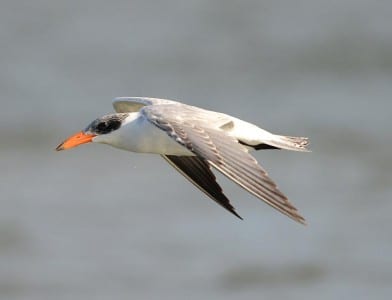
We have three wintering terns common on our beaches. This is the Caspian Tern, easily recognized by the thick, red bill. They also don’t have as deeply forked tail as a Royal, as the latter have much longer f lights out to their feeding grounds. Their call’s loud, raucous and descending, far more of an attention-getter than a Royal’s.
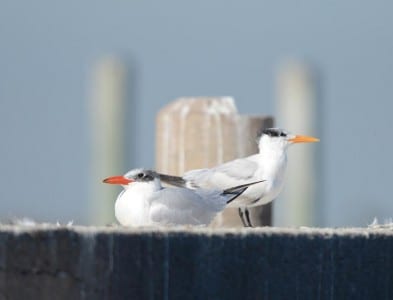
This is a good comparison between a Royal on right and a Caspian on left. Note the thinner, less red beak on the Royal, p lus a shaggy crest (although it covers less of the face). We have many more Royals here but Caspians have a much greater Worldwide distribution. There are 3-4 times as many Royals nesting in Galveston Bay.
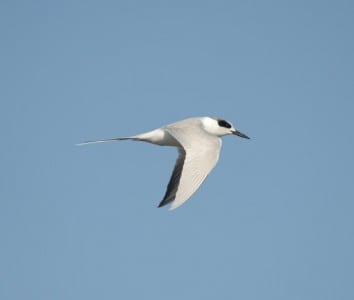
The smaller tern here in winter (all three above are year-round) is the Forster’s, with a black bill and often quite a long tail. The black line through the eye but white crown distinguishes them from a leftover Common Tern here in winter, and any Sandwich wintering would have a yellow bill tip (and be larger with a shaggy crest). Also note how light the wings are, without dark primaries.

 Posted in
Posted in 
























Does Crystal Beach have any deadly animals in it?
Just wish to say your article is as astounding. The clearness in your post is just cool and I can assume you are an expert on this subject. Fine with your permission let me to grab your feed to keep updated with forthcoming post. Thanks a million and please carry on the rewarding work.